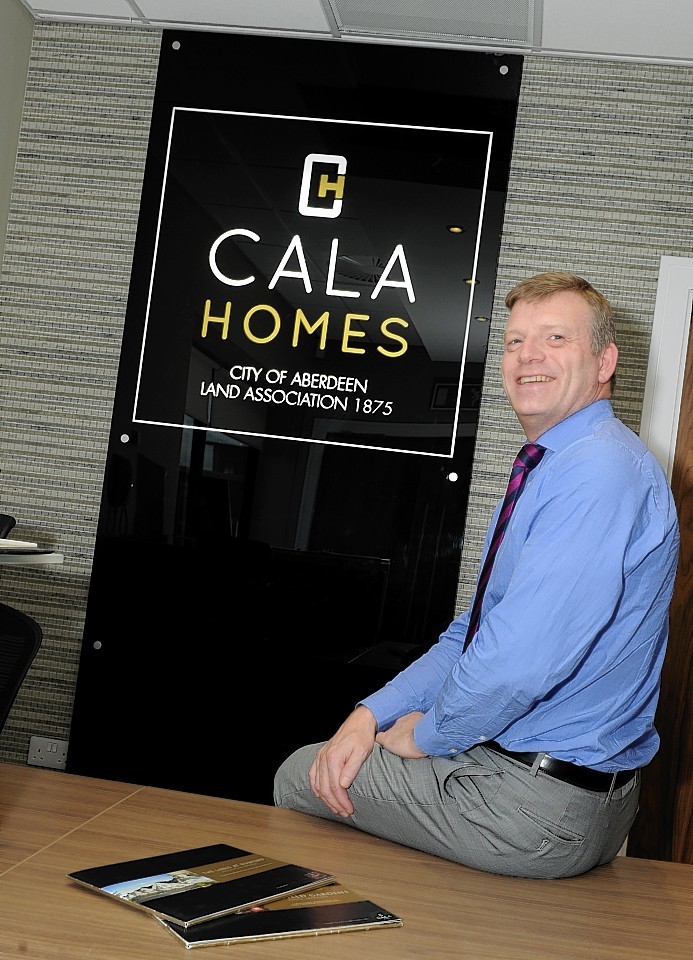If there were any signs that the north-east’s house building industry was slowing down along with the oil price, Mike Naysmith would be in a good position to see it, writes Erikka Askeland
Cala Homes has been in Aberdeen- in some form or another – for 140 years.
It used to be called City of Aberdeen Land Association, and was the first Scottish company to be listed on the London Stock Market before its name was changed to a sleek acronym in intervening decades.
Mr Naysmith became managing director of the firm’s newly formed North division in 2013 – a result of one of the firms most recent changes in structure following its £210million acquisition by insurance giant Legal & General and private equity firm, Patron Capital Partners.
Except for a few years stint at a rival – covering some difficult years in which the indebted housebuilder Cala had been largely taken over by its lender Lloyds Banking Group – Mr Naysmith has been with the firm since he joined as a young planner.
As a result, he has seen some of the city’s ups and downs before.
He said: “We are conscious of what is happening in the oil market at the moment, but we are equally conscious that the levels of interest we are getting on our current sites don’t seem to be affected.”
He said a show home that opened on one of its sites in the Granite city three weeks ago had 100 people through the door on its first weekend.
“Part of that confidence is because of a shortage. All of these sites coming forward are in areas which haven’t had anything for years.
“Even in the best years we were only building half as many houses as was needed to meet its population projections.”
The company has just moved into a prominent new office at Arnhall Business Park – the better to allow its growing number of staff. These include Fraser Carr, the firm’s new sales and marketing director who was lured away from local rival, Stewart Milne.
He said the company hopes to start building on four new sites in the Granite city this year. This includes 46 apartments at Cornhill Hospital and a further 109 home development in Cults. But its largest project is a site in Milltimber, on the woodland site of a former granite Victorian mansion.
Initially the company will build six large detached houses there, but the development will eventually sprawl to 550 private houses.
The company going ahead with the first phase after finally agreeing a “section 75” – a levy which the housebuilder pays to fund schools and other associated public amenities.
But it hasn’t been a smooth process. Mr Naysmith said delays in Aberdeen City Council’s planning department have set the build back.
“The planning department services has improved the last 12 to 18 months. But Milltimber is a prime example – we got planning permission in April but it took us until today to get the section 75.
“There is no coordination between departments. Some of the departments are clearly under-resourced.”
But he is sympathetic, as the council has difficulty recruiting enough planners just like most employers in the Granite city due to the cost of living.
“It is the chicken and the egg. If you had enough housing the cost of living would drop. You can’t get housing because you can’t get people to deal with the planning applications,” he notes.
The firm is putting emphasis on its 140th anniversary this year.
Cala was founded by Arthur Anderson, a former lord provost of Aberdeen.
“We own everything from the top of Union Street right up to and past Rubislaw Quarry, but we feued it all off to people for their houses,” says Mr Naysmith.
The company still owns many of the back lanes across the city – which people redeveloping offices often find when they try to expand.
“Queens Road is the way it is because of Cala. We insisted on houses being set back a certain distance and being built of granite and slate. It is good to be able to say we are responsible for how it looks.”
Q&A
Who helped you get where you are today?
My father was the main driver behind what I do today. He was a fabric and carpet designer. I never had the flair for that but I was always interested in building.
What do you still hope to achieve in business?
Consolidating what we’ve got to make something the whole company is proud of.
If you were on government, what would you change?
Making the planning system far easier. A bit more ownership from council officials and councillors – it is far too easy for them to make a decision with no consideration of the consequences.
What are you reading or watching recently?
Mostly I read car magazines. I thought 50 Shades of Grey was a colour chart.
What car do you drive and what do you dream of driving?
I’ve got an Audi A7. My dream car has always been Porsche 911 – just because it was a picture on my wall when I was young.
What charity do you support?
I’m a director of Cash For Kids.
